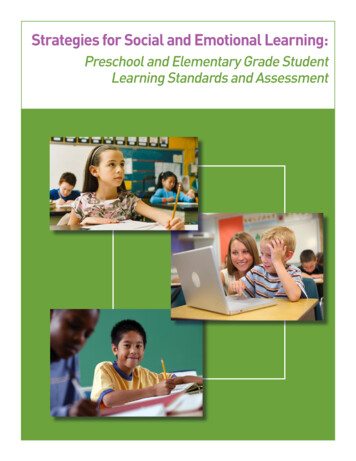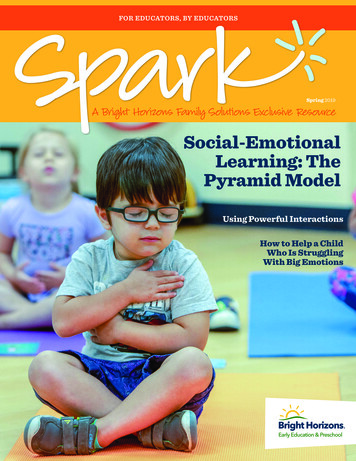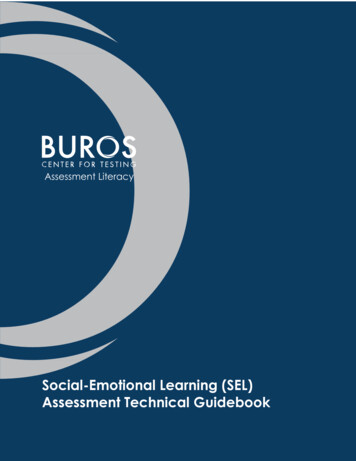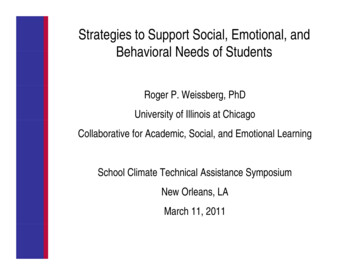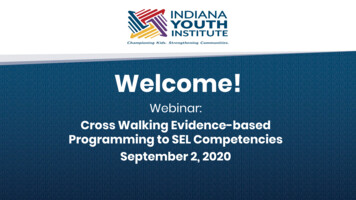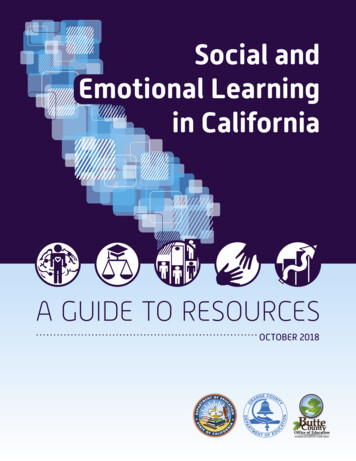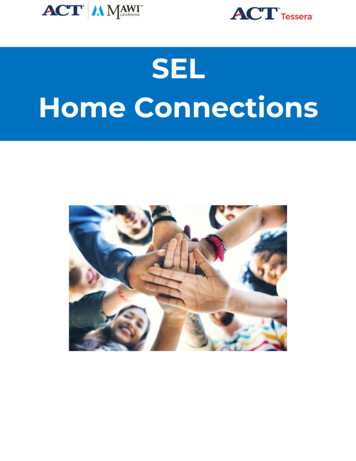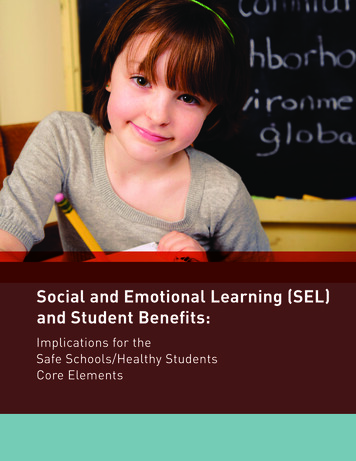
Transcription
Social and Emotional Learning (SEL)and Student Benefits:Implications for theSafe Schools/Healthy StudentsCore Elements
IntroductionThis brief shares the latest research on the effects of social and emotional learning(SEL) on students and includes strategies for implementing SEL. It explains how SELworks, elaborates on how SEL can be an integrative prevention framework thataddresses the Safe Schools/Healthy Students (SS/HS) core elements, and spells outimplications of the research for SS/HS grantees.Research clearly demonstrates the significant role of SEL in promoting the healthydevelopment and academic achievement of all students. It also shows that SEL reducesproblem behaviors and emotional distress that interfere with the learning anddevelopment of some students. Research indicates that SEL programming significantlyraises test scores while it lowers levels of emotional distress; disruptive behavior; andalcohol, tobacco, or other drug use. SEL is thus an effective approach for addressing theSS/HS core elements: safe learning environments and violence prevention activities;substance abuse prevention; behavioral, social, and emotional supports; mental healthservices; and early childhood SEL programs.SEL is the process through which children and adults acquire the knowledge, attitudes,and skills associated with the core areas of social and emotional (SE) competency:Self-Awareness: identifying and recognizing emotions; accurate self-perception;recognizing strengths, needs, and values; self-efficacySelf-Management: impulse control and stress management; self-motivationand discipline; goal setting and organizational skillsSocial Awareness: perspective taking; empathy; difference recognition;respect for othersRelationship Skills: communication, social engagement, and relationshipbuilding; working cooperatively; negotiation, refusal, and conflict management;help seekingResponsible Decision-making: problem identification and situationanalysis; problem solving; evaluation and reflection; personal, social, andethical responsibilitySEL programming promotes the development and use of these SE competencies inthe context of creating safe and supportive school, family, and community learningenvironments in which children feel cared for, respected, connected to school, andengaged in learning. Many evidence-based programs are available to help schoolspromote the development of these competencies in students. In addition, because SEcompetencies are believed to be an important mechanism of action for preventionprograms (i.e., students learn these skills and put them into practice), many substanceabuse, violence prevention, and health promotion programs also stress thedevelopment of SE competencies.1Research Implications for theSafe Schools/Healthy Students Core Elements
What Does the Research Say?Several hundred well-designed studies havedocumented the positive effects of SEL programmingon students of diverse backgrounds, from preschoolthrough high school, in urban, suburban, and ruralsettings. This research indicates that well-plannedand well-implemented SEL programming can positivelyaffect a broad range of student social, health, behavioral,and academic outcomes.1, 22008 Meta-Analysis of SEL ProgramsSome of the most compelling information comes fromfindings of the largest, most scientifically rigorousreview of research ever done on interventions thatpromote children’s social and emotional development.3This review of more than 700 studies published through2007 included school, family, and communityinterventions designed to promote social and emotionalskills in children and adolescents between the ages of 5and 18. This large sample of studies was divided intothree main areas: studies about (a) school-basedinterventions, (b) after-school programs, and (c) programsfor families. Our focus here is on results of the schoolbased research, which included 207 studies of programsinvolving 288,000 students.In this meta-analysis (study of studies), researchersused statistical techniques to summarize the findingsacross all the studies and found a broad range ofbenefits for students: 9% decrease in conduct problems, such as classroommisbehavior and aggression 10% decrease in emotional distress, such as anxietyand depression 9% improvement in attitudes about self, others,and school 23% improvement in social and emotional skills 9% improvement in school and classroom behavior 11 % improvement in achievement test scores2Research Implications for theSafe Schools/Healthy Students Core ElementsIt is important to note that while these SEL programstook time out of the school day, they did not detractfrom student academic performance. In fact, as notedabove, on average, students receiving school-based SELscored 11 percentile points higher on academicachievement tests than their peers who did not receiveSEL, and they also attained higher grades. And even asgrades and achievement test scores were improving,classroom behavior, feelings about self, and emotionalproblems were improving as well.Three other key findings from the meta-analysis haveimportant implications for SS/SH grantees. First,students achieved significant gains across all six of theoutcome areas studied only when the SEL program waswell implemented. For instance, program effectivenesswas compromised if staff failed to conduct certain partsof the intervention, or new staff members arrived andwere insufficiently prepared to deliver the program. Thisfinding suggests schools must invest the time andresources necessary to implement programs in a highquality way.Second, significant gains were only seen across these sixareas when classroom teachers were the primaryimplementers (as opposed to outside researchers). Thisfinding demonstrates that school staff can effectivelyconduct SEL programs and schools do not need to hireoutside personnel for effective delivery. Using existingstaff may also increase the likelihood that SEL becomesan essential and routine part of school life attended toby all staff rather than a marginal add-on provided byonly a few.Finally, only programs and interventions characterizedas “S.A.F.E.” achieved significant gains across all sixoutcome areas. S.A.F.E. programs and interventions: Use a Sequenced set of activities to develop SEskills in a step-by-step fashion; Use Active forms of learning, such as role-plays andbehavioral rehearsal that provide students withopportunities to practice SE skills;
Focus attention on SEL, with at least eight sessionsdevoted to SE skill development; and Explicitly target particular SE skills for development,with skills identified in lessons’ learning objectives.Schools that expect to get results from SE competencypromotion will focus on not only what skills they areteaching but how they are teaching them. See thesidebar for an example of how S.A.F.E. is illustrated inone evidence-based SEL program.Additional Factors InfluencingSEL Program OutcomesPrevious research has identified additional factorsinfluencing SEL program effectiveness. Based on thesefindings, schools should also pay particular attention toprogram duration, program scope, and leadershipsupport. More specifically, research suggests that: More intense programs of longer duration(multiyear) typically have greater effect than shorter,less intense programs.1 SEL should be started inpreschool and continued through high school. Programs that focus on changing behaviors tend tobe more effective when addressed in multiplesettings, for example, school, home, and community.4 Leadership (principal, district-level) support is acritical factor in high-quality implementation.5Such support makes it more likely that schools willhave the resources and ongoing professionaldevelopment they need to implement programs asintended and that SEL is an integral part of overallschool improvement efforts.3Research Implications for theSafe Schools/Healthy Students Core ElementsHow an Evidence-based SELProgram Incorporates S.A.F.E.Below is an example of how an evidence-based programuses S.A.F.E. in its overall program design and how it isused in the classroom. Promoting Alternative ThinkingStrategies (PATHS) is an elementary school curriculumdesigned to promote children’s social and emotionalcompetence and critical thinking skills by providinginstruction in and practice of a broad range of social andemotional skills.Each lesson of the PATHS program specifies a learningobjective related to teaching one of the four explicit socialand emotional skills (i.e., identifying emotions, managingemotions, solving problems, and building relationships) onwhich the program focuses. Lessons build on one anotherin a sequence of active learning activities designed toenhance students’ understanding of a skill through guidedpractice. One example of how PATHS uses these fourstrategies is a series of lessons for children in grades 1 andyounger on increasing self-control and decreasingimpulsivity as a prerequisite to using problem solving andadaptive interpersonal skills. In these lessons, childrenlearn and practice the three steps of the Turtle techniqueto “withdraw into their shell —to calm themselves whenstrong feelings or other problems make them want tostrike out: (1) Tell yourself to stop; (2) Take one long deepbreath; and (3) Say the problem and how you feel.”
Logic Model: How SEL WorksHow Evidence-Based SEL Programs Work to ProduceGreater Student Success in School and Life (CASEL)Evidence-Based SEL Programs:12Create safe, caring,well-managed, andparticipatory learningenvironmentsProvide social andemotional Social awarenessRelationship skillsResponsible decision-makingGreater attachmentto schoolLess risky behaviorand more assets andpositive developmentThere is extensive evidence that the two key elementsof evidence-based SEL programs—(1) creating positiveschool learning environments and (2) providing SEcompetency instruction—result in greater academicperformance and better long-term life outcomes.6, 7These two key elements of SEL programs are mutuallyreinforcing. Classrooms filled with socially andemotionally skilled students are more caring and safe,and positive learning environments provideopportunities for students to use and further developSE competencies.How SEL contributes to positive outcomes for youthis described in more detail below and illustrated in thelogic model shown above.4Research Implications for theSafe Schools/Healthy Students Core ElementsCaring, capable,responsible,motivated studentsBetter academicperformanceEffective workers(1) Contributing to Positive School LearningEnvironments: Positive learning environments havecaring teacher-student relationships at their center. Theyare also well-managed, participatory, and hold highexpectations for all students. They use instructional andclassroom management strategies that address students’social and emotional needs. These environments aremotivating and psychologically and physically safe.Students in these environments feel more connected topeers, teachers, and their school, and they are more likelyto adopt the prosocial and proacademic norms promotedby these individuals and settings.8 Students in thesesettings have better academic performance andattendance, as well as significantly lower rates ofemotional distress, violence, delinquency, substanceabuse, and sexual activity.9,10,11,12,13.14
(2) Providing SE Competency Instruction: In order toparticipate fully and respectfully in a relationshipcentered environment, however, students need basicsocial and emotional skills. They need to managethemselves appropriately and interact positively withothers. SE competency instruction helps all childrento engage in these behaviors more effectively. SELinstruction can also produce significant improvementsin school-related attitudes, behaviors, and performance.2Socially and emotionally competent students are betterable to take advantage of classroom learningopportunities and experiences and facilitate ratherthan disrupt the learning of their peers.15 Furthermore,when teachers integrate the teaching of SEL withacademic content, student understanding of subjectmatter improves.16,17 There is also evidence thatproviding emotional regulation skills actually improvescognitive functioning.18These same core SEL skills also help children avoid riskybehaviors. Social competency instruction significantlydecreases delinquency and alcohol and other drug use.14Numerous studies have concluded that the mosteffective prevention programs provide SE competencyinstruction, particularly in decision-making, refusal, andemotional regulation skills.19,20For more on CASEL’s SEL logic model go tohttp://www.casel.org/basics/logic.php.5Research Implications for theSafe Schools/Healthy Students Core Elements
How SEL Can Help SS/HS Grantees Address the Core Elements?SS/HS Core Elements with Sample SELEvidence-based Programs and OutcomesSS/HS Core ElementSample SEL Evidence-Sample Outcomesbased Program(s)Safe school environmentsand violence preventionactivitiesCaring School CommunityResponsive ClassroomSteps to Respect 24% stronger academic motivation 33% greater sense of the school as acaring community 12% more liking for schoolAlcohol, tobacco, and other drugprevention activitiesLions Quest Lower alcohol and marijuana use Lower lifetime and 30-day use of alcohol,30-day binge drinking, 30-day cigaretteuse, lifetime marijuana use, and currentuse of beer, liquor, and chewing tobaccoCaring School CommunityStudent behavioral, social andemotional supportsPATHS (Promoting AlternativeThinking Strategies) 20% increase in students’ scores oncognitive skills tests 32% reduction in teachers’ reports ofstudents exhibiting aggressive behavior 36% increase in teachers’ reports ofstudents exhibiting self-control 68% increase in students’ emotionalvocabularyMental health servicesSocial Decision-Making andProblem-Solving Program Lower levels of depression, self-destructivebehavior, and delinquencyEarly childhood social and emotionallearning programsHigh Scope Educational Approachfor Preschool and Primary Grades Less time in special education More success in life as indicated by higherlevels of graduation from 12th grade, lesslikelihood of being arrested, and higherearly adult incomesTable 16Research Implications for theSafe Schools/Healthy Students Core Elements
Social and emotional competency promotion addressesthe risk and protective factors common to a broadrange of problem behaviors (risky, disruptive, anddelinquent). Because it occupies this central place ineffective prevention programming (as table 1illustrates), it can serve as a coordinating frameworkfor universal prevention programming that meets theneeds of all students.21 SEL promotes a common setof protective factors in two ways:Because the same core SE competencies andenvironmental supports are important at all levels ofintervention, SEL can also serve to coordinate earlyintervention supports and intensive treatment forstudents who are at risk or already experiencing mentalhealth problems. Figure 1 illustrates this public healthapproach to providing mental health supports forstudents at various levels of need. By helping students develop a core set of skills,such as anger management and refusal skills, thatare relevant to preventing a wide range ofhigh-risk behaviors.Treatment By promoting other protective factors, such asincreased student connectedness, academicachievement, and perceived levels of social support,something that results from both SE competencypromotion and strategies that improve the learningenvironment.By focusing on shared protective factors, universal SELprograms not only offset the harm posed by risk factorsbut also promote positive healthy development.Addressing problem behaviors while promoting essentiallife skills is important because “being problem-free is notthe same as being well-developed.”22By promoting a common set of protective factors, SELprovides a prevention framework that connects the coreSS/HS elements by systematically addressing thenumerous underlying social and emotional variables thatare shared by these core elements and that affect learningand development.Just as important, SEL provides a shared language andmutually reinforcing set of strategies that helpovercome fragmentation, minimize competition forresources, and strengthen program effectiveness inaddressing the core elements.7Research Implications for theSafe Schools/Healthy Students Core ElementsFigure 1IntensivePrevention1–5%High-Risk 5–10%At-Risk StudentsClassroom/Small GroupStrategiesUniversalPrevention80–90%All StudentsSchool-wideSystemsof Support
What This Research Means for SS/HS GranteesThe following recommendations for SS/HS grantees arebased on the research described above, as well as thefirsthand experiences of schools that have adopted anSEL frameworkUsing SEL as a Prevention Framework Make SE competency promotion central to schoolprevention efforts by providing skills instructionand creating positive learning environments. Address implementation issues by proactivelyanticipating barriers and responding effectivelywhen issues arise. Address multiple risk and protective factors sharedby many problem behaviors and mental healthissues by using SEL programming that focuses onpromoting SE competency and creating a safe,caring learning environment. Support classroom teachers in integrating SEcompetency promotion into core subject areas (e.g.,language arts and empathy skills; scienceexperiments and the problem-solving framework)and using SEL instructional practices (e.g.,cooperative learning, dialogic inquiry) so that SELcan become a part of routine classroom practicethroughout the day. Select an evidence-based program that matchesstudents’ needs for SE competency promotion andsupports school staff in improving the schoolenvironment. Expand zero tolerance approaches to violenceprevention to include a focus on teaching core SEskills and creating safe, caring learning environments. Assess current practices to see how well the fourevidence-based S.A.F.E. strategies are integrated inthe school’s SEL and academic programming.Implementing and Integrating SEL Gain the support of school leadership to enhanceimplementation, achieve positive outcomes, and laythe foundation for long-term sustainability. Invest in ongoing professional development. It isessential to high-quality implementation and theachievement of successful outcomes. Make sure toprovide skills training for all adult members of theschool community so that everyone can teach,model, and reinforce SE skills in a variety of settingsbeyond the classroom.8 Implement evidence-based programs and practiceswith fidelity (as they are intended). Becauseprogram implementation quality influencesoutcomes, work with program developers ifadaptations are needed to avoid interfering with theessential components that make the program work.Research Implications for theSafe Schools/Healthy Students Core Elements Seek out opportunities to integrate and reinforce theuse of key SE knowledge, skills, and concepts fromthe evidence-based SEL school program at home,through after-school programs, and in targetedsupports and interventions provided by school staffor community providers.Promoting SE competencies through school-based SELprogramming is central to effective preventionprogramming and can be a framework to coordinate thecore SS/HS elements. SEL researchers and practitionersagree that by systematically promoting students’ SEcompetency and by establishing learning environmentsthat meet the social and emotional needs of students,schools help them succeed in school and life.
Endnotes1. Greenberg, M. T., Weissberg, R. P., O’Brien, M. U., Zins, J. E., Fredericks, L., Resnik, H., & Elias, M. J. (2003).Enhancing school-based prevention and youth development through coordinated social, emotional, andacademic learning. American Psychologist, 58, 466–474.2. Zins, J. E., Weissberg, R. P., Wang, M. C., & Walberg, H. J. (Eds.). (2004). Building academic success on socialand emotional learning: What does the research say? New York: Teachers College Press.3. Durlak, J. A., Weissberg, R. P, Taylor, R. D., & Dymnicki, A. B. (in preparation). The effects of school-based socialand emotional learning: A meta-analytic review.4. Greenberg, M. T., Domitrovich, C., & Bumbarger, B. (2001). The prevention of mental disorders in school-agedchildren: Current state of the field. Prevention & Treatment, 4, Article 1.5. Kam, C. M., Greenberg, M. T., & Walls, C. T. (2003). Examining the role of implementation quality in schoolbased prevention using the PATHS curriculum. Prevention Science, 4(1), 55–63.6. Elias, M. J. (2006). The connection between academic and social-emotional learning. In M. J. Elias and H.Arnold (Eds.). The educator’s guide to emotional intelligence and academic achievement: Social-emotional learningin the classroom. (pp. 4–14). Thousand Oaks, CA: Corwin Press.7. Payton, J. W., Graczyk, P., Wardlaw, D., Bloodworth, M., Tompsett, C., & Weissberg, R. (2000). Social andemotional learning: A framework for promoting mental health and reducing risk behavior in children andyouth. Journal of School Health, 70, 179–185.8. Hawkins, J. D., Catalano, R. F., & Miller, J.Y. (1992). Risk and protective factors for alcohol and other drugproblems in adolescence and early adulthood: Implications for prevention. Psychological Bulletin, 112(1),64–105.9. Resnick, D., Bearman, P., Blum, R., Bauman, K., Harris, K., Jones, J., Tabor, J., Beuhring, T., Sieving, R., Shew,M., Ireland, M., Bearinger, L., & Udry, R. (1997). Protecting adolescents from harm: Findings from the NationalLongitudinal Study on Adolescent Health. JAMA, 278, 823–832.10. Osterman, K. F. (2000). Students’ need for belonging in the school community. Review of Educational Research,70: 323–367.11. Blum, R. W., McNeely, C. A., & Rinehart, P. M. (2002). Improving the odds: The untapped power of schoolsto improve the health of teens. Minneapolis: University of Minnesota, Center for Adolescent Healthand Development.12. Hawkins, J. D., Catalano, R. E., Kosterman, R., Abbott, R., & Hill, K.G. (1999). Preventing adolescent health-riskbehaviors by strengthening protection during childhood. Archives of Pediatrics and Adolescent Medicine, 153,226–234.13. Symons, C. W., Cinelli, B., James, T. C., & Groff, P. (1997). Bridging student health risks and academicachievement through comprehensive school health programs. Journal of School Health, 67(6), 220–227.14. Wilson, D. B., Gottfredson, D. C., & Najaka, S. S. (2001). School-based prevention of problem behaviors:A meta-analysis. Journal of Quantitative Criminology, 17, 247–272.9Research Implications for theSafe Schools/Healthy Students Core Elements
15. Linares, O. L., Rosbruch, N., Stern, M. B., Edwards, M. E., Walker, G., & Abikoff, H. B. (2005). Developingcognitive-social-emotional competencies to enhance academic learning. Psychology in the Schools, 42(4),405–417.16. Elias, M. J. 2004. Strategies to infuse social and emotional learning into academics. In J. E. Zins, R. P.Weissberg, M. C. Wang, H. J. Walberg (Eds). Building academic success on social and emotional learning:What does the research say? (113–134) New York: Teachers College Press.17. Schaps, E., Battistich, V., & Solomon, D. (2004). Community in school as key to student growth: Findings fromthe Child Development Project. In J. E. Zins, R. P. Weissberg, M. C. Wang, H. J. Walberg (Eds.). Buildingacademic success on social and emotional learning: What does the research say? (189–205) New York:Teachers College Press.18. Riggs, N. R., Greenberg, M. T., Kusche, C. A., & Pentz, M. A. (2006). The mediational role of neurocognitionin the behavioral outcomes of a social-emotional prevention program in elementary schools students: Effectsof the PATHS curriculum. Prevention Science, 7(1), 91–102.19. Dusenbury, L., & Hansen, W. B. (1998). Safe schools, safe students: A guide to violence prevention strategies.Washington, DC: Drug Strategies.20. Dusenbury, L., & Falco, M. (1995). Eleven components of effective drug abuse curricula. Journal of SchoolHealth, 65(10), 420–425.21. Greenberg, M.T. (2007). School-based prevention: Current status and future challenges. Working paper forInstitute of Medicine/National Research Council Committee on Prevention of Mental Disorders. Washington, DC.22. Adelman, H.S., & Taylor, L. (2008). Technical assistance sampler on protective factors/resilience.Downloaded June 1, 2008, from ncy/resilien.pdf.10Research Implications for theSafe Schools/Healthy Students Core Elements
ResourcesCollaborative for Academic, Social, and EmotionalLearning. (2003). Safe and sound: An educationalleader’s guide to evidence-based social and emotionallearning programs. Chicago: Author.For more on the knowledge and skills associated withthe core SE competencies, go to: http://www.casel.org/basics/skills.php and ial-emotional%20learning.html.For more on the Illinois SEL learning standards, go to:http://isbe.net/ils/social emotional/standards.htm his brief, supported by Grant Number 2HR1SM54865 from theSubstance Abuse and Mental Health Services Administration(SAMSHA), was written by the Collaborative for Academic, Social,and Emotional Learning (CASEL) in collaboration with The NationalCenter for Mental Health Promotion and Youth Violence Preventionwhich is managed by the Education Development Center. Thecontents of this brief are solely the responsibility of the authors anddo not necessarily represent the official views of SAMHSA or HHS.11Research Implications for theSafe Schools/Healthy Students Core Elements
SEL is thus an effective approach for addressing the SS/HS core elements: safe learning environments and violence prevention activities; substance abuse prevention; behavioral, social, and emotional supports; mental health services; and early childhood SEL programs. SEL is the process through which children and adults acquire the knowledge, attitudes, and skills associated with the core areas .
